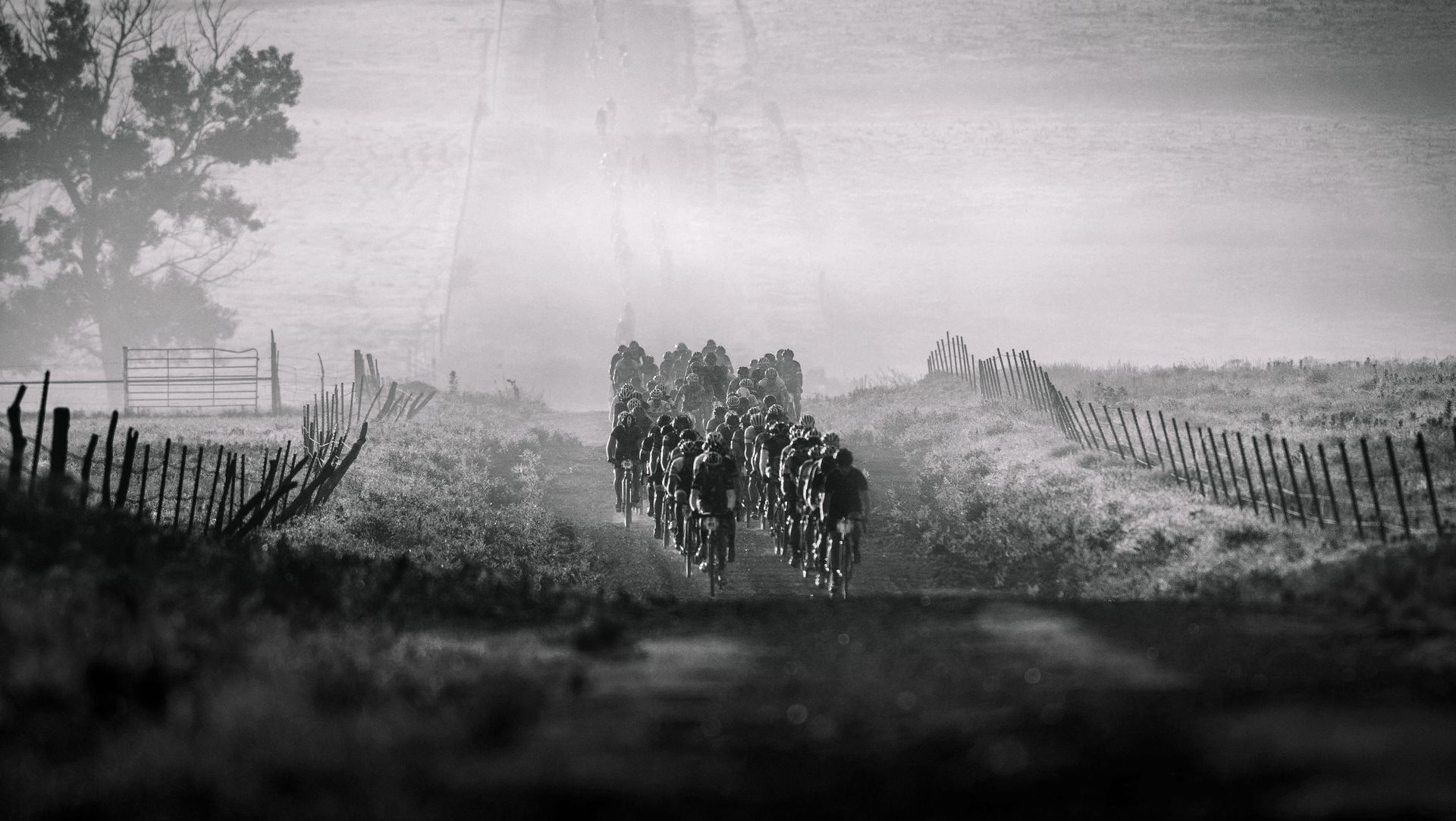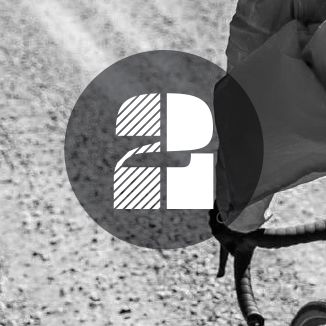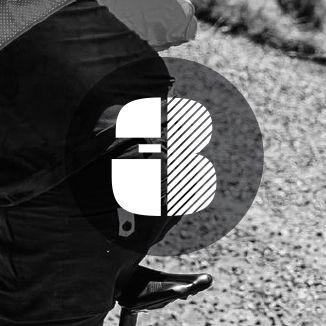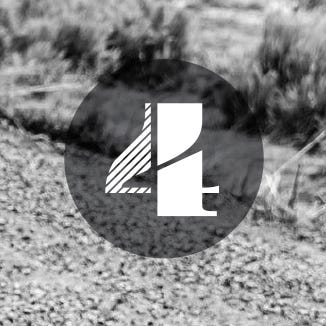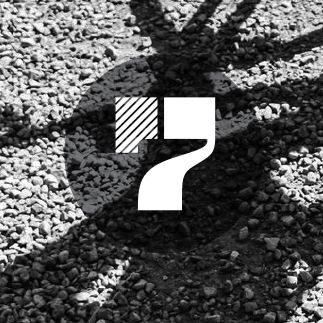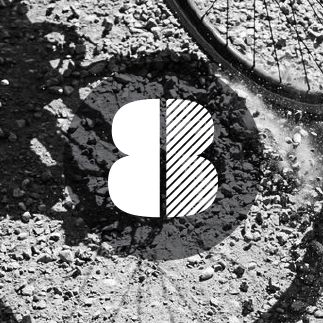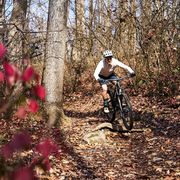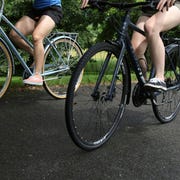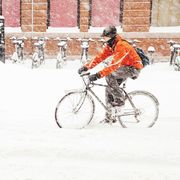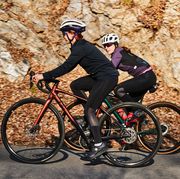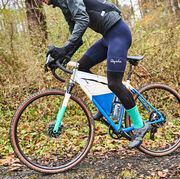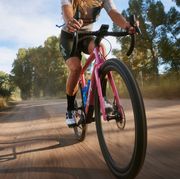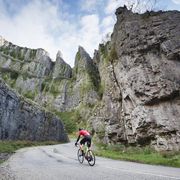Event promoters and experienced racers get asked “is this a race or a ride” all the time, because when someone new goes to a registration page, the language can be a bit vague. That’s likely intentional. The spirit of gravel has traditionally been more about the experience—traversing this amazing and sometimes amazingly challenging terrain to the best of your ability—than crossing the finish line first. However, cyclists being cyclists, when we pay money and zip-tie number plates to our bars, we want to know our results. Many of us want to race. Others, however, get turned off by an ultra competitive gravel-racing environment, which is why defining these rides is so tricky.
With their audience in mind, gravel race promoters generally do an excellent job of creating an event that walks the line between a challenging, fun day on the bike and a hardcore competition. Some events run “mullet racing style” (aka business in the front, party in the back), meaning all the people gunning for a podium or PR line up at the front of the starting corral, and the “let the good times roll” crowd hovers in the back.
Other events incorporate a more “social racing” format. Instead of the race being “on” from start to finish, these races set up an assortment of timed segments throughout the course, and the winner is the person who gets the fastest cumulative time. That way, riders can turn themselves inside out racing the segments if they wish, and yet still have a largely social day, chit chatting and enjoying what the aid stations have to offer without worrying about sacrificing their overall placement.
Grinduro, held in California’s Sierra Nevada range, cooked up the first really popular iteration of this concept. The 60-mile high-alpine loop features more than 7,500 feet of climbing and descending on pavement, gravel, singletrack, and dirt roads. Riders roll out for a mass start at a casual pace, then compete for the fastest times on four climbing and descending segments. Pennsylvania’s Keystone Gravel is another event that embraces this format.
These days, there are also gravel stage races, such as the Oregon Trail Gravel Grinder and the Queen’s Stage Race in Idaho.
The general vibe is always fun-forward. You’ll often find pre- and post event parties, expo areas, social shakedown rides, and even bands and large festivals.
All that said, a race is a race is a race. So don’t be surprised if that same woman who was all peace, love, and happiness at the bar the night before is side-eyeing you on the start line and attacking once the gun goes off the next morning. Whenever there are other cyclists, a clock, and a finish line (or any such permutation), there will be riders coming in wearing game faces.
Don't take it personally. Race your race. Or don’t race your race. Find your tribe, find your vibe, and settle in. The real beauty of gravel is that it's what you want it to be.
How Long Will I Be Out There?
If you’re used to doing all your rides on pavement, expect to knock a couple of mphs off your average speed right out of the gate. Bigger and knobbier tires, even with file treads, are not going to be as quick as slick road tires. Generally speaking (unless you have an aero gravel bike), gravel bikes are not designed to be particularly aero. So even if you’re riding silky smooth dirt (or pavement), you can expect to go about 1 to 2 mph slower.
And of course, there’s the terrain and the elements to consider, and how that terrain mingles with the elements. Broadly speaking, if you average 15 to 16 mph on your hilly road rides, you’ll likely average 12 to 14 on a gravel ride with similar total elevation, depending on the road surface. Obviously, the tougher the terrain (think: lots of mud, loose gravel, sand) the slower you’re going to go.
You might find yourself 65 miles into the plains at Dirty Kanza in Kansas going downhill, still pedaling, and going a whopping 11 mph. That’s how strong the headwind can be. In those moments you might feel like you’ll be out there for days, not hours, before you see the finish. But headwinds generally turn to tailwinds at some point, so you just have to keep the faith—and keep pedaling.
In general, if you do events, it’s good to be able to ballpark your average speed. Many of the big races—especially the 200 milers like Michigan’s Coast to Coast Gravel Grinder and DK200—have cutoff times. When there are time cuts, race promoters often use 10 mph as their minimum speed. So for DK200 you have 20 hours to finish. Cutoff times aren’t just for your own well-being; they’re also for those hardworking volunteers, many of whom have already been shuttling boxes and bags and setting up aid stations since 5 o’clock in the morning. If a race has cutoff times, they’ll list them in the race bible, on the website, or in the pre-race rider meetings.
But if you train and prepare, barring unforeseen mishaps, you can generally reach the finish line well within the cutoff times. And the somewhat slower gravel speeds give you more time to appreciate the incredible terrain.
10 Race Day Survival Tips
1. Get up early. Give yourself time to eat a good breakfast, have some coffee, use the restroom (likely multiple times), and get to the start in time to line up.
2. Check the weather. Make sure there are no surprises on the horizon. (Carry a light shell layer just in case.)
3. Keep moving. Limit your refueling stops to five or 10 minutes max. Avoid sitting or lying down in the aid stations unless you’re in a really bad way, because honestly, it just makes it worse as your legs stiffen up. Better to roll out slowly and recover on the bike than to spend a half hour hanging around.
4. Plan your aid station stops. Do your future, completely brain-fried self a major favor by planning your refueling and aid station stops in advance. Organize your drop bags in an orderly fashion with easy access to your electrolytes, preferred food, spare parts, chain lube, and whatever else you may need. If you have your own support crew, make a game plan so everyone knows what you’ll need and how to take care of you and your bike to keep you rolling.
5. Share the work. Find a pack of riders going your speed and work within it, taking turns at the front, pulling in the wind. It'll make everyone’s day easier!
6. Stick to your pace! When the gun goes off a lot of people go off fast—too fast. Don’t be one of them. Yes, it feels like you’re being left behind, but you’ll see them later when they crack during the second half of the race. This is where training with a heart rate monitor really helps. You can keep an eye on your heart rate during the event and keep it where you know it’s sustainable.
7. Conserve your matches. It’s inevitable that you’re going to have to go into the red a little here and there to crest a steep kicker or get through a rough patch. Keep those moments when you’re burning matches to an absolute minimum.
8. Expect the unexpected. A race like Kanza is an extremely long day over sometimes brutal terrain. Mechanicals are common. You may go off course. You may run into unpredicted weather. Keep your chin up and deal with whatever problems arise without flipping out about them.
9. Stay cool! The DNF rate soars when the temperatures rise. It’s hard enough for your body to maintain a reasonable core temperature over an effort of 12 or more hours when it’s 60°F and sunny. Raise the temps 20 degrees, and it can be nearly impossible without assistance, which makes heat illness a real risk. Have a plan to keep your fluids ice-cold (thermal bottles help). Pour cold water over your head at refuel stations (or when a nice roadside farm stand offers you some). And riders have been known to pack nylon socks in their drop bag, which they fill with ice and tuck into the back collar of their jerseys to cool their core.
10. Remember the laws of endurance. Keep in mind, no matter how bad you feel or how good you feel, it won’t last. The tunnel is dark when you’re in it, but there’s light at the other end. Make forward progress, no matter how slow, and take care of yourself with food, fluids, and positive thinking. It’ll get you to the finish line.
What to Expect
Thousands of riders flock to gravel events for their chill, friendly vibe and grassroots feel. Even as these events have grown—with some seeing literally thousands of racers along with pros of Tour de France level—the heart and soul of personal challenge and adventure remain.
That’s not to say that there aren’t people who are going to take it all pretty seriously. If you’re one of them, that’s okay. Or maybe you’re going to pack beer in your drop bag and make a day of it. That’s cool, too. The only time I’ve seen people become disappointed is when their expectation didn’t match the reality of what they found. They expected everyone to be chill and groovy, and there were still plenty of racers stewing in nerves with their game faces firmly in place when it was time to get to the line. To avoid that problem, take this advice.
Race your own race or ride your own ride.
Don’t be a jerk.
Know the rules of your particular event. Organizers put together “race bibles” that outline everything you need to know: where the aid stations are located or even if there are aid stations (you really want to know that); what type of food, water, and/or mechanical support is provided; if or how the course will be marked; and what basic conduct is expected of riders.
Embrace self-sufficiency. Many of the original events (which also had free entries) provided little more than a map. You had to be 100 percent self-sufficient and fuel up at gas stations along the way. Newer rides have evolved away from that, with most providing aid or assistance in some form. But most still expect you to take care of yourself and not have a team of domestiques working for you.
Communicate with your support crew. If you’re allowed outside assistance in the form of a support crew, be sure to clearly communicate your needs. Make sure you’ve got all the food and supplies you’ll need (or think you'll need) ready beforehand, and double check that what your support crew plans to do aligns with what you have in mind.
Relax and have fun! That’s most important. Gravel races are invariably held in beautiful, often really remote places that are literally saturated in scenery. Even if you’re gunning for a podium spot or personal best, remember to put your head up and soak in some of the beauty. It’ll take the edge off of the suffering, and remind you why you’re there.
Keep Rolling
“Things are going to go wrong. For whatever reason, something always seems to go wrong on race day.” That was my coach, Craig Sheckler, warning me that despite nearly a year of meticulous training and preparation for Ironman, Louisville, something was bound to go awry at the big event, because that’s just how it goes. “Just do what you can to keep making forward progress and take care of yourself.”
And when the cable slipped out of my front derailleur that’s exactly what I did. I summoned every last morsel of my meager mechanical abilities to cinch the cable back in and get moving again. When the heat and effort made me nearly vomit at mile 2 of the marathon, I grabbed an orange slice from the aid station and did the same—kept on moving.
Big gravel events take place over the course of many hours—often up to most of a day—over very rugged, generally unfamiliar terrain, and you are rolling along with hundreds of other riders. You’re vulnerable to wildlife, the weather, and the whims of fate. Don’t lose your shit if something goes wrong. Calmly inspect the situation, remedy it as best you can, and keep on rolling.
Also, take a few extra measures of precaution to prevent very common mishaps.
Pocket some portable lube. Dry dusty roads will cause your chain to dry quickly, making it harder to shift and roll smoothly. Carry a small bottle of chain lube, and give your chain a quick reapplication at the aid stations.
Carry a little chamois cream. Your bike’s undercarriage won’t be the only thing getting cranky from a long day in the saddle. Especially if you have a history of saddle sores or known problem areas, adding a little extra lube to your own undercarriage will help prevent hot spots and worse. Apply liberally.
Wear sunscreen. Sunburn is a form of injury and can increase your risk of heat illness. You want neither when you have 90 more miles to go. Apply sport sunscreen to every bit of exposed skin, and leave some in your drop bag or with your support crew so you can spray on more at the aid stations.
Have a treat. Delicious snacks that you actually look forward to eating will help buoy your spirits when they’re sinking. Even the pros do this. Former professional road racer Tetrick, who, as mentioned earlier, carries a little bourbon “just in case,” also treats herself to doughnut holes and frosted animal crackers because they make her happy. And in the end, gravel is supposed to be fun! ❖

